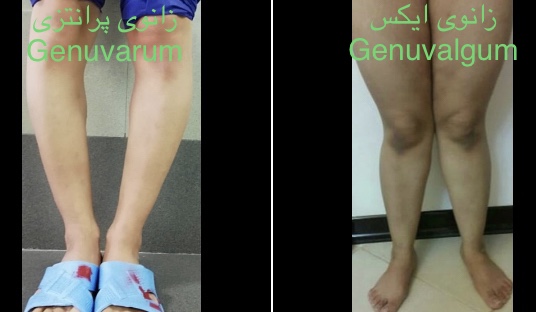Causes of knee deviation, diagnosis and treatment

At the beginning of the discussion, it is better to know what determines the disorder and how normal and abnormal are known
Naturally, we never expect all the knees to be straight and straight, and like other parts of the body, a little deviation is acceptable and acceptable.
A normal knee is defined as one that did not cause problems for the person at that moment in the first step, i.e. did not cause pain or restrictions, and in the second step
A good future should be predicted for it, that is, it should not be subject to premature destruction
Naturally, not all knees are expected to be straight
A slight deviation from the natural axis may be acceptable without causing any problems either now or in the future
Therefore, in addition to the appearance of the body, the existing symptoms or future predictions are effective in commenting
In a simpler way, it should be said that in a standing position and when both your feet are facing you and the toes and heels of both feet are attached to each other, the distance between the knees is considered normal.
And in another case, in those who have X-knee or genu valgus, on the contrary, when the two knees are stuck together, the distance between the ankles of the two legs is less than a fist.
When the paws are together, it looks at the kneecaps, i.e. the opposite patella
The causes of knee axial disorder are divided into primary and secondary categories
In the initial cases, the disorder is without a specific background, nature, and genetics, and the person inherits this disorder in a family way
In secondary or evolutionary cases, in fact, an underlying problem, such as bone softness, may have caused deviations and disturbances in bone growth.
Also, sometimes injuries of the growth plate during the growth period and sometimes ligament injuries may also cause organ axis disorders
Another type of axial knee disorder may occur due to erosive diseases or arthritis, which will accelerate the erosion process.
In rheumatic diseases, genovalgoma or X-knee disorder is mostly seen, although this does not mean that everyone who has genovalgoma has rheumatism.
Some behaviors and sports may also change the shape of the joint over time, for example, martial artists and football players have knee braces.
Of course, this may also mean that those who have knee braces are more successful in this type of sports, and in fact, a natural selection has occurred, and more studies should be done.
Regarding treatment, it should be said:
The type of treatment depends on various factors, including the severity of changes in existing problems and the age of the person
The role of braces and corrective exercises in the treatment of this disorder is still debated, but it certainly has no place in adults
As a rule, surgery should be done when its advantage is preferable to not doing it
Share :
 English
English
 Persain
Persain

Add New Comment